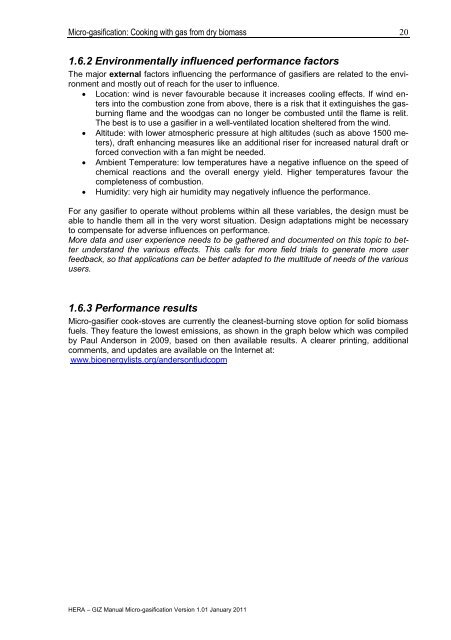Micro-gasification: Cooking with gas from biomass - Amper
Micro-gasification: Cooking with gas from biomass - Amper
Micro-gasification: Cooking with gas from biomass - Amper
You also want an ePaper? Increase the reach of your titles
YUMPU automatically turns print PDFs into web optimized ePapers that Google loves.
<strong>Micro</strong>-<strong><strong>gas</strong>ification</strong>: <strong>Cooking</strong> <strong>with</strong> <strong>gas</strong> <strong>from</strong> dry <strong>biomass</strong><br />
1.6.2 Environmentally influenced performance factors<br />
The major external factors influencing the performance of <strong>gas</strong>ifiers are related to the environment<br />
and mostly out of reach for the user to influence.<br />
Location: wind is never favourable because it increases cooling effects. If wind enters<br />
into the combustion zone <strong>from</strong> above, there is a risk that it extinguishes the <strong>gas</strong>burning<br />
flame and the wood<strong>gas</strong> can no longer be combusted until the flame is relit.<br />
The best is to use a <strong>gas</strong>ifier in a well-ventilated location sheltered <strong>from</strong> the wind.<br />
Altitude: <strong>with</strong> lower atmospheric pressure at high altitudes (such as above 1500 meters),<br />
draft enhancing measures like an additional riser for increased natural draft or<br />
forced convection <strong>with</strong> a fan might be needed.<br />
Ambient Temperature: low temperatures have a negative influence on the speed of<br />
chemical reactions and the overall energy yield. Higher temperatures favour the<br />
completeness of combustion.<br />
Humidity: very high air humidity may negatively influence the performance.<br />
For any <strong>gas</strong>ifier to operate <strong>with</strong>out problems <strong>with</strong>in all these variables, the design must be<br />
able to handle them all in the very worst situation. Design adaptations might be necessary<br />
to compensate for adverse influences on performance.<br />
More data and user experience needs to be gathered and documented on this topic to better<br />
understand the various effects. This calls for more field trials to generate more user<br />
feedback, so that applications can be better adapted to the multitude of needs of the various<br />
users.<br />
1.6.3 Performance results<br />
<strong>Micro</strong>-<strong>gas</strong>ifier cook-stoves are currently the cleanest-burning stove option for solid <strong>biomass</strong><br />
fuels. They feature the lowest emissions, as shown in the graph below which was compiled<br />
by Paul Anderson in 2009, based on then available results. A clearer printing, additional<br />
comments, and updates are available on the Internet at:<br />
www.bioenergylists.org/andersontludcopm<br />
HERA – GIZ Manual <strong>Micro</strong>-<strong><strong>gas</strong>ification</strong> Version 1.01 January 2011<br />
20
















